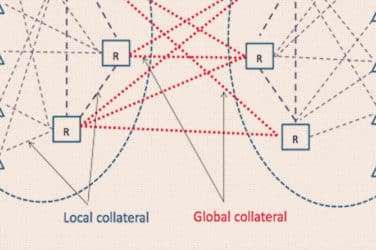
ForexClear, part of the London Stock Exchange Group’s clearing house LCH, has seen an increase in client clearing volumes as the buy side prepares for the next phases of the uncleared margin rules.
Tamaryn Nuttall, chief operating officer at ForexClear, told Markets Media: “The buy side is a focus for us and we have been building momentum in our client clearing volumes over the last 12 months. Many firms are looking to clear as much as possible to try and reduce their uncleared portfolio to below the thresholds for the uncleared margin rules.”
She continued that client clearing volumes have significantly increased, with $13.8bn (€12.4bn) being cleared in the third quarter of this year.
“Clients are getting ready for the next two phases of the uncleared margin rules, which are due to be implemented from next year,” she added.
In September this year phase four of the uncleared margin regulation came into force, with phase five, covering more fund managers, due in September next year. Regulators began implementing the mandate to exchange initial margin on uncleared derivatives in 2016 in annual waves. The implementation thresholds are based on firms’ notional amounts of outstanding contracts of the derivatives that fall under the regulation.
Clarus Financial Technology, the derivatives analytics provider, said in a blog that there is some evidence of phase four boosting volumes of cleared non-deliverable forwards as September was a record month.
NDF Clearing September 2019 https://t.co/A7ZEixnCo3 pic.twitter.com/pv0Jx4gJKi
— Clarus (@clarusft) October 9, 2019
“Data shows clearing rates as high as 29%,” added Clarus. “NDF markets are thriving. Average daily volumes as reported by the BIS have nearly doubled in the past three years.”
NDFs are derivatives that are used to hedge or speculate against currencies where exchange controls make it difficult for overseas investors to make a physical cash settlement, for example, the Chinese renminbi.
Clearing FX forwards
This month LCH said it had expanded its deliverable FX clearing to include FX forwards in eight currency pairs.
#FX Forwards now available for #clearing at @LCH_Clearing's #ForexClear. Read the press release: https://t.co/OgVG3fhI4S pic.twitter.com/arRzlBGtmk
— LCH (@LCH_Clearing) October 16, 2019
Nuttall said that prior to the launch of clearing outright FX forwards, the business already cleared FX forwards as hedges to cleared options.
“In partnership with CLS we have extended clearing to deliverable FX forwards across the portfolio,” she added. “We are aiming to expand the range of currency pairs for cleared FX forwards in 2020, subject to regulatory approval.”
LCH said the product incorporates the first physical FX settlement for cleared FX products, which it developed in collaboration with CLS. The majority of settlement in the foreign exchange market takes place through the CLS, the bank-owned infrastructure which was set up to reduce counterparty risk.
Tom Prickett, co-head of EMEA Rates, at J.P. Morgan said in a statement: “The launch of cleared FX forwards unlocks more opportunities for improved risk management and operational efficiencies.”
David Warren, group chief financial officer of LSEG, said on the third quarter results call this month that growth in OTC clearing had been very strong.
“In addition to SwapClear, the ForexClear business is continuing to develop over time and we are pleased with progress,” added Warren. “We can clear a wider range of FX products. Adding forwards is a significant development that we have been working on for a long time.”
FX options
The product extension follows the launch of deliverable FX options clearing last year. Nuttall said there are seven members live and actively clearing deliverable FX options.
“In the third quarter of this year we cleared £168bn in deliverable notional and the average is £4bn a day,” she added. “There are a number of new members in the pipeline who will join in 2020.”
There is also client demand to clear non deliverable options and Nuttall said ForexClear is exploring that capability.
“Once we have delivered non deliverable options, we will look to extend the currency pairs we clear as well as extending the tenor of our products which is currently a maximum of two years,” she added.
For example, ForexClear is reviewing extending the tenor of cleared NDFs for Brazilian Real up to five years and is also seeing demand for euro crosses and USD/CAD.
ForexClear also offers compression for FX forwards and non-deliverable forwards. Compression allows clients to reduce the notional and trade count in their portfolios and increase capital efficiency through “tearing up” offsetting trades while maintaining the same risk profile.
“Compression is attractive for members who want to net their exposures to comply with the capital requirements for GSIBs,” said Nuttall.
GSIBs are classified by regulators as globally systemically important financial institutions based on their risk-weighted assets.
FX execution
Consultancy Greenwich Associates said in a report this month that adoption of FX algos jumped in 2018 after remaining flat over the over the last five years.
*New* FX Execution: Competing in a World of Algos https://t.co/h4gY9r9Jdz via @GreenwichAssoc by #SatnamSohal, #FrankFeenstra pic.twitter.com/Y7vPVJzpbu
— Greenwich Associates (@GreenwichAssoc) October 22, 2019
The report said that after last year’s spike, about one fifth of FX market participants are now trading via algorithm—a share that is consistent across North America and Europe, and on the rise in Asia.
Satnam Sohal, principal at Greenwich Associates and co-author of the study, said in a statement: “As FX market participants adopt sophisticated pre- and post-trade analytics enhanced by artificial intelligence and machine learning, the potential benefits of algo trading are becoming clear, and hedge funds and real money accounts are leading the charge.”
Curtis Pfeiffer, chief business officer at Pragma, a multi-asset quantitative trading technology provider, said in an email to Markets Media that it is no surprise that there has been an increase in the adoption of FX execution algorithms.
“The growth in the number of market participants supporting NDF algos over the past couple of years and the increasing ways algorithms can be customized via strategy behavior and/or venue selection enables FX algos to handle more and more trader’s orders,” he added.








